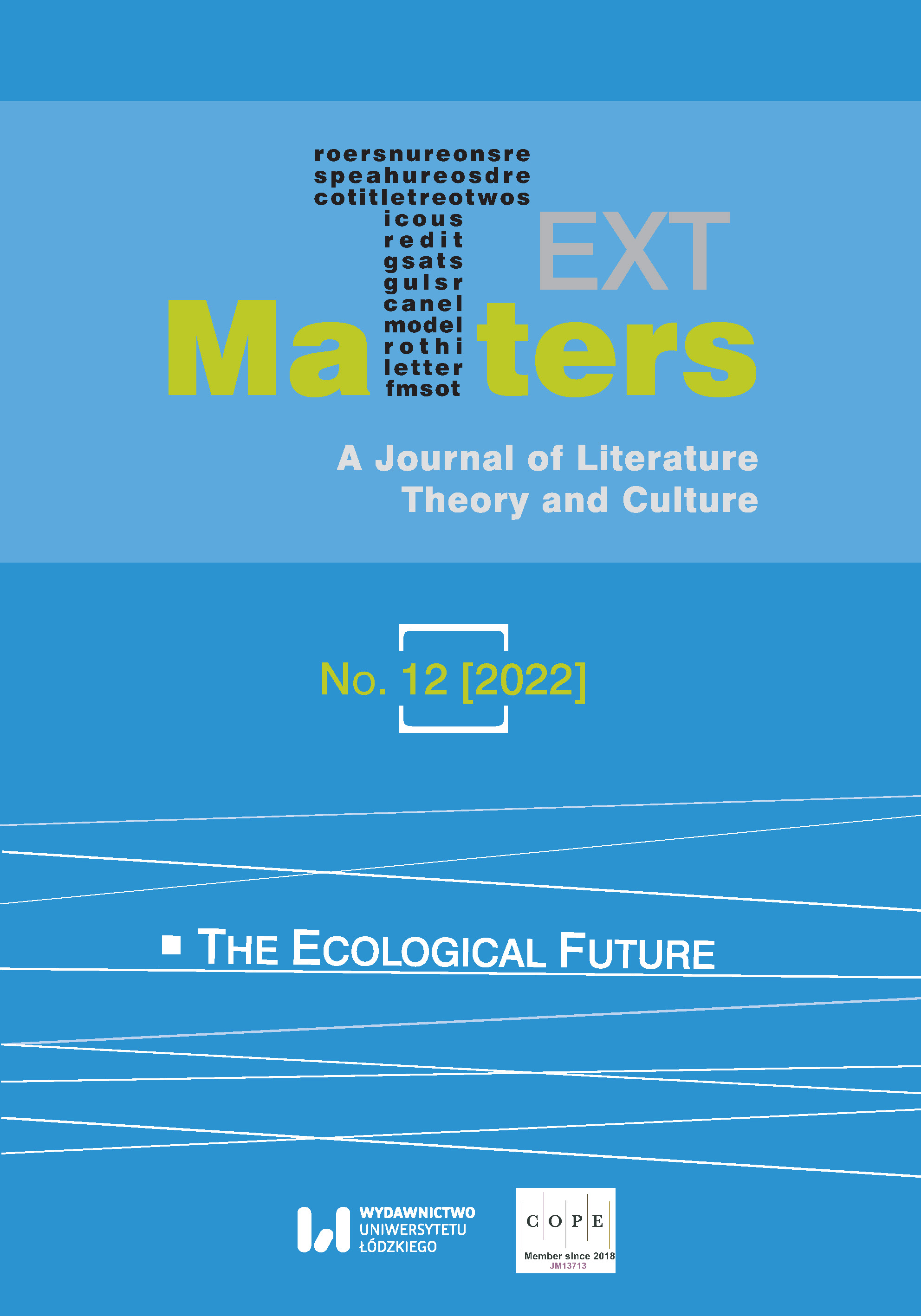Museum Project: 14 Henrietta St. Museum, Paula Meehan, Dragana Jurišić and the Irish Housing Crisis
DOI:
https://doi.org/10.18778/2083-2931.12.27Keywords:
Paula Meehan, Dragana Jurišić, 14 Henrietta St. Museum, Irish housing crisis, memory, museumAbstract
The aim of the article is to compare three (re)creative activities within one interdisciplinary project: a public space (14 Henrietta St. Museum in Dublin), poetry (Paula Meehan’s cycle of sonnets in Museum of 2019) and photography (Dragana Jurišić’s photos in the same book). They are all examined in the light of the current housing crisis in Ireland, which followed the collapse of the Celtic Tiger in 2008. The Museum project not only comments on the crisis and the changing social relations in Ireland but also challenges the perception of history and private/public memory. In the article, the components of the project are situated against biographical and historical backgrounds, and within the framework of new museology, memory studies, and the functions of photography and poetry.
Downloads
References
“14 Henrietta St. Museum.” Museum website, Dublin City Council, https://14henriettastreet.ie accessed 3 Nov. 2020.
Google Scholar
“14 Henrietta Street—Making a Museum.” Video, Dublin City Council Culture Company, https://14henriettastreet.ie/about/making-a-museum/ accessed 9 May 2022.
Google Scholar
“About Homelessness.” Focus Ireland, https://www.focusireland.ie/focus-blog/review-of-7-years-of-spending-on-homelessness-shows-its-time-to-change/ accessed 11 Nov. 2020.
Google Scholar
Allen Randolph, Jody. “The Body Politic: A Conversation with Paula Meehan.” An Sionnach: A Journal of Literature, Culture, and the Arts, vol. 5, no. 1–2, Spring/Autumn 2009, pp. 239–71.
Google Scholar
Barthes, Roland. Camera Lucida: Reflections on Photography. Translated by Richard Howard. Hill and Wang, 1980.
Google Scholar
Bazarnik, Katarzyna. Personal interview. 27 Nov. 2019.
Google Scholar
Bolter, David Jay, and Richard Grusin. Remediation: Understanding New Media. MIT, 1999. https://doi.org/10.1108/ccij.1999.4.4.208.1
Google Scholar
DOI: https://doi.org/10.1108/ccij.1999.4.4.208.1
Clapham, David F., William A. V. Clark, and Kenneth Gibb, editors. The SAGE Handbook of Housing Studies. SAGE, 2012. https://doi.org/10.4135/9781446247570
Google Scholar
DOI: https://doi.org/10.4135/9781446247570
Drong, Leszek. Tropy konfliktu. Retoryka pamięci kulturowej we współczesnej powieści północnoirlandzkiej. Wydawnictwo Uniwersytetu Śląskiego, 2019.
Google Scholar
Erll, Astrid. “Cultural Memory Studies: An Introduction.” Cultural Memory Studies. An International and Disciplinary Handbook, edited by Astrid Erll and Ansgar Nünning, De Gruyter, 2008, pp. 1–18. https://doi.org/10.1515/9783110207262
Google Scholar
DOI: https://doi.org/10.1515/9783110207262
Erll, Astrid, and Ann Rigney. “Introduction: Cultural Memory and its Dynamics.” Mediation, Remediation, and the Dynamics of Cultural Memory, edited by Astrid Erll and Ann Rigney, De Gruyter, 2009, pp. 1–14. https://doi.org/10.1515/9783110217384.0.1
Google Scholar
DOI: https://doi.org/10.1515/9783110217384.0.1
Fitzgerald, John. “Ireland’s Recovery from Crisis.” CESifo Forum, vol. 2, June 2014, pp. 8–13.
Google Scholar
Frawley, Oona. Irish Pastoral: Nostalgia in Twentieth-Century Irish Literature. Irish Academic P, 2005.
Google Scholar
Hayden, Joanne. “I believe that two lines of poetry can save a life—Paula Meehan.” The Independent, 6 May 2018, https://www.independent.ie/entertainment/theatre-arts/i-believe-that-two-lines-of-poetry-can-save-a-life-paula-meehan-36865589.html accessed 4 Nov. 2020.
Google Scholar
Healy, Seán. “Towards an Inclusive and Just Recovery.” Debating Austerity in Ireland: Crisis, Experience and Recovery, edited by Emma Heffernan, John McHale and Niamh Moore-Cherry, Royal Irish Academy, 2017, pp. 255–69. https://doi.org/10.2307/j.ctt1x76dck.23
Google Scholar
DOI: https://doi.org/10.2307/j.ctt1x76dck.23
“History of the House.” 14 Henrietta St. Museum, Museum website, Dublin City Council, https://14henriettastreet.ie/about/history-of-the-house/ accessed 3 Nov. 2020.
Google Scholar
Jurišić, Dragana. Author’s website, https://www.draganajurisic.com/ accessed 8 Nov 2020.
Google Scholar
Jurišić, Dragana. Interview by Joanna Kruczkowska. 5 Mar. 2021.
Google Scholar
Jurišić, Dragana, and Paula Meehan. Museum. Dublin City Council Cultural Company, Dublin City Council, 2019.
Google Scholar
Leahy, Pat. “Dublin inner city project punches well above its weight.” The Irish Times, 26 Dec. 2020, https://www.irishtimes.com/opinion/dublin-inner-city-project-punches-well-above-its-weight-1.4444954 accessed 12 Apr. 2021.
Google Scholar
Lotman, Yuri. Universe of the Mind: A Semiotic Theory of Culture. Translated by Ann Shukman. Indiana UP, 1990.
Google Scholar
“Macroeconomic Imbalances. Country Report—Ireland 2015.” European Economy. Occasional Papers, vol. 215, June 2015. European Commission: Economic and Financial Affairs, https://ec.europa.eu/economy_finance/publications/occasional_paper/2015/op215_en.htm accessed 9 May 2022.
Google Scholar
Meehan, Paula. Dharmakaya. Carcanet, 2000.
Google Scholar
Meehan, Paula. Geomantic. Dedalus, 2016.
Google Scholar
Meehan, Paula. Painting Rain. Carcanet, 2009.
Google Scholar
Mullaly, Una. “The truth about the Magdalene laundries was hiding in plain sight.” The Irish Times, 2 June 2019, https://www.irishtimes.com/culture/heritage/the-truth-about-the-magdalene-laundries-was-hiding-in-plain-sight-1.3900697 accessed 23 Feb. 2021.
Google Scholar
O’Halloran, Eileen, and Kelli Maloy. “An Interview with Paula Meehan.” Contemporary Literature, vol. 43, no. 1, Spring 2002, pp. 1–27. https://doi.org/10.2307/1209014
Google Scholar
DOI: https://doi.org/10.2307/1209014
O’Loughlin, Ed. “A Blot on Ireland’s Past, Facing Demolition.” The New York Times, 15 Jan. 2018, https://www.nytimes.com/2018/01/15/world/europe/magdalene-laundries-ireland.html accessed 23 Feb. 2021.
Google Scholar
Ó Riain, Seán. “Ireland’s Recovery: Explanation, Potential and Pitfalls.” Debating Austerity in Ireland: Crisis, Experience and Recovery, edited by Emma Heffernan, John McHale and Niamh Moore-Cherry, Royal Irish Academy, 2017, pp. 219–34. https://doi.org/10.2307/j.ctt1x76dck.21
Google Scholar
DOI: https://doi.org/10.2307/j.ctt1x76dck.21
O’Sullivan, Marc. “Seated Portrait of Paula Meehan and Dragana Jurišić.” Dragana Jurišić’s website, https://static1.squarespace.com/static/60cb2a25d498554e2e6ee807/t/60d06a770b089649712a8d62/1624271490007/museum_dragana_paula.jpg/ accessed 4 Nov. 2020.
Google Scholar
O’Sullivan, Marc. “Standing Portrait of Paula Meehan and Dragana Jurišić.” The Irish Times, 25 July 2019, https://www.irishtimes.com/news/ireland/irish-news/images-of-the-day-1.3967628 accessed 4 Nov. 2020.
Google Scholar
Pine, Emilie. The Politics of Irish Memory. Palgrave Macmillan, 2011. https://doi.org/10.1057/9780230295315
Google Scholar
DOI: https://doi.org/10.1057/9780230295315
Shine Thompson, Mary. “Paula Meehan’s Dublins: Landscape, Community and Poetic Identity.” Reading Ireland: The Little Magazine, vol. 11, Winter 2019, pp. 52–63.
Google Scholar
Sontag, Susan. On Photography. Farrar, Straus and Giroux, 1973.
Google Scholar
Witcomb, Andrea. Re-Imagining the Museum: Beyond the Mausoleum. Routledge, 2003. https://doi.org/10.4324/9780203361023
Google Scholar
DOI: https://doi.org/10.4324/9780203361023
Published
How to Cite
Issue
Section
License

This work is licensed under a Creative Commons Attribution-NonCommercial-NoDerivatives 4.0 International License.













